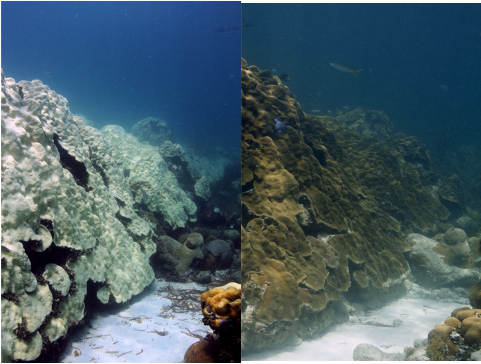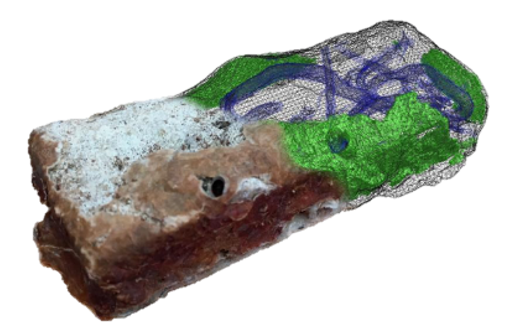The National Coral Reef Monitoring Program
Monitoring Climate Driven Impacts on US Coral Reefs
SCROLL TO LEARN MORE
What We Do
The National Coral Reef Monitoring Program (NCRMP) is the largest monitoring program in the world designed to support the conservation of coral reef ecosystems. NCRMP provides consistent, sustained, and long‐term measurement of key indicators that gauge the status and trends of coral reef health. As part of NCRMP, AOML leads the in-situ climate change and ocean acidification monitoring for the Atlantic Ocean.
We work in collaboration with NOAA’s Pacific Marine Environmental Laboratory (PMEL) in Seattle, Washington, and the Ecosystem Sciences Division of the Pacific Islands Fisheries Science Center (PIFSC) in Honolulu, Hawaii. The NCRMP climate monitoring was created to provide high-quality data to understand how a changing climate is impacting the nation’s coral reef ecosystems.
Who We Are
| Kayelyn Simmon, Ph.D.
Oceanographer
| Albert Boyd
Coral Carbonate Chemist
| Ben Chomitz
Digital Morphology Technician
| Taylor Gill
Mission: Iconic Reef Climate Monitoring Coordinator
Exploring the Marine Environment in
The Dry Tortugas
Take a trip with us to one of the sentinel sites for the National Coral Reef Monitoring Program, the Dry Tortugas. We recently went out for maintenance and sampling at the site and we took videos to share along the way. Click the video to see our field journal and to get a first hand view of what it’s like to be aboard a scientific research cruise for coral monitoring.
Read More News
Research Impacts & Key Findings
AOML scientists have led 16 NCRMP cruises to six field sites in the Atlantic, Caribbean, and Gulf of Mexico gathering valuable data used to provide a comprehensive view of the effects of climate change on coral reef ecosystems.
Over 25 peer-reviewed publications have used NCRMP climate data from moored oceanographic instruments stationed at fixed points in the Atlantic Ocean, water samples collected by divers, and satellite-based observations.
AOML NCRMP scientists have processed over 3000 water samples. The data is used to examine coral response to precise, controlled changes in environmental conditions and determine coral resilience to stressors such as rising temperatures, ocean acidification, and nutrient flux.
Detecting Changes in the Ocean
The National Coral Reef Monitoring Sites
The National Coral Reef Monitoring Program’s climate component currently monitors sites in the U.S. Virgin Islands, Puerto Rico, Florida, and the Flower Garden Banks. These locations are visited on a rotational basis with data beginning in 2013. See the most recent field report from the Dry Tortugas below.
Research Indicators
National Coral Reef Monitoring Program Indicators
We monitor many factors that can affect the health of coral reefs. We measure thermal stress, which is how corals handle rising temperatures, bioerosion which is a natural process where reef organisms slowly remove reef rock under living corals, and carbonate chemistry including ocean acidification which happens as the ocean absorbs more carbon dioxide from the atmosphere. We have unique methods for monitoring these indicators to assess ecosystem health. Click next to read more.
Monitoring Ecological Impacts with BMUs
Bioerosion monitoring Units are used to monitor in situ bioerosion rates on coral reefs. Measuring ecological responses to climate changes allows the investigation of the relationship between biological response variables to both physical and chemical processes.
Ocean Acidification and Carbonate Chemistry
Ocean acidification can threaten coral reef accretion by reducing calcification rates in reef‐building organisms and by enhancing the bioerosion of the reef framework. Climate-NCRMP collects seawater carbon chemistry samples to assess the dissolved inorganic carbon (DIC) and total alkalinity (TA).
Sentinel Ocean Acidification site at Cheeca Rocks

The AOML coral program moored autonomous pCO2 (MApCO2) buoy that measures the partial pressure of CO2 (pCO2) in seawater, temperature, salinity, and pH every three hours and relays these data in near-real-time to the PMEL where they are publicly available online at PMEL’s Coral Reef Moorings website. These efforts are part of and adhere to the data quality requirements of the larger Global Ocean Acidification Monitoring Network. Some of the key ecosystem variables being measured at each MapCO2 buoy site to gauge the impacts of climate change and ocean acidification are: 1) ecosystem and species-specific calcification rates; 2) calcium carbonate budgets; and 3) rates of bioerosion.
Driving Innovative Science with
Landscape Mosiacs
Landscape mosaics document a visual representation of coral cover and benthic structure at a specific time period. Coral cover is quantified and compared between each mosaic. Landscape mosaics are collected by taking many underwater images and stitching them together.
Featured Publication
Publications & References
Click to Expand List
Manzello, D. P., Kolodziej, G., Kirkland, A., Besemer, N., & Enochs, I. C. (2021). Increasing coral calcification in Orbicella faveolata and Pseudodiploria strigosa at Flower Garden Banks, Gulf of Mexico. Coral Reefs, 1-15.
PaperHu, X., M.F. Nuttall, H. Wang, H. Yao, C.J. Staryk, M.M. McCutcheon, R.J. Eckert, J.A. Embresi, M.A. Johnston, E.L. Hickerson, G.P. Schmahl, D.P. Manzello, I.C. Enochs, S. DiMarco, and L. Barbero. Seasonal variability of carbonate chemistry and decadal changes in waters of a marine sanctuary in the northwestern Gulf of Mexico. Marine Chemistry, 205:16-28, doi:10.1016/j.marchem.2018.07.006 2018 FY2018. Paper
Manzello, D. P., Enochs, I. C., Kolodziej, G., & Carlton, R. (2015). Recent decade of growth and calcification of Orbicella faveolata in the Florida Keys: an inshore-offshore comparison. Marine Ecology Progress Series, 521, 81-89. Paper
Manzello, D. P., Enochs, I. C., Melo, N., Gledhill, D. K., & Johns, E. M. (2012). Ocean acidification refugia of the Florida Reef Tract. PloS one, 7(7), e41715. Paper
U.S. Coral Reefs Status Report
NOAA’s National Coral Reef Monitoring Program Releases 2020 Coral Reef Status Report
In Fall 2020, NOAA’s Coral Reef Conservation Program (CRCP) released the National Status Report for U.S. Coral Reefs. The Coral Reef Conservation Program supports the National Coral Reef Monitoring Program throughout the U.S. Pacific, Atlantic, Gulf of Mexico, and Caribbean coral reef areas.
The report provides a high-level overview – capturing the time period from 2012-2018 – of coral reef health for all of the U.S. coral reefs in the Pacific, Atlantic, Caribbean and Gulf of Mexico. The report is the culmination of a five-year collaboration between CRCP, the University of Maryland Center for Environmental Science’s Integration and Application Network, and numerous partners in every jurisdiction from state and territorial governments, academia and non-governmental organizations.





























